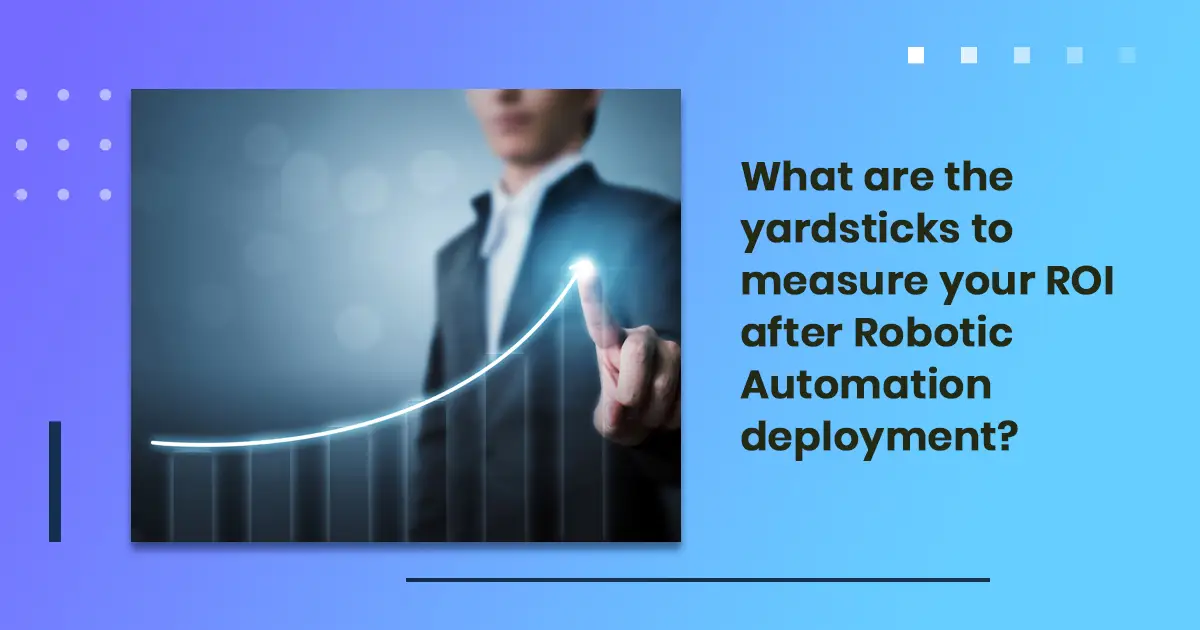
What are the yardsticks to measure your ROI after Robotic Automation deployment?
Dec 29, 2023
The quick and easy benefits of RPA has contributed to quick adoption of RPA amongst companies of all sizes. Yet, many companies seek answers on how to measure their ROI after implementing RPA. Some companies automate only vital processes, some in stages and others try to implement across all departments.
According to the PWC Auditing firm, “We estimate that 45% of work activities could be automated, and this automation would save $2 trillion in global workforce costs”. These figures are staggering and also consolidates the unique position RPA is enjoying in the automation industry.
What PWC has given is a global figure, but for a small firm, what are the yardsticks used to calculate its ROI for the hard earned money it has invested?
Also Read: Role of CFO in implementing Robotic Process Automation
What are the yardsticks employed?:
Let us look at it below:
- Selectivity Criteria - to automate the right process:
The first step is the most crucial step for the success of automation, to select the right processes for automation. If you identify processes that are repetitive in nature requiring no cognitive skills, then these are the processes you can automate first. This would give you a quick ROI. - Rationality Criteria - to measure the ratio:
Some of the factors that can be used for this calculation are the time saved, labor cost saved, error reductions. You can also use how much additional revenue you were able to generate with the same resources that were freed up by using robotic automation. -
Rapidity Criteria - to measure process speed:
It is understood that back-office processes remain the ideal area for deploying automation. Bot velocity - meaning the bots work non-stop delivering results at a rapid pace. Due to this velocity, you will be able to complete processes which used to take hours and weeks, in minutes and hours. This reduction in cycle time of work completion can be used as a benefit in your ROI calculation. -
Reviewability Criteria - to measure the output quality:
Bots are less likely to make errors. So, the costs related to erroneous output and rechecking of the work is reduced drastically. If the erroneous output is sent to clients there could be potential issues, followed by root cause analysis etc. All these can be avoided by usage of bots. This is another factor that can be used for ROI computation. -
Compliance Criteria - to measure accountability and governance:
This metric is based on validating the critical points in the robotic process to ensure rules are carried out and compliance is met. Success is measured when humans cannot bypass the decision point unless specifically set compliance requirements are met. Robots are programmed to alert employees on compliance procedures so timely decisions are made. So, adherence to compliance is another metric you can use for ROI calculation. -
Utility Criteria - to measure short- and long-term goals:
The percentage utilization metric is used to capture the capacity of bots needed for automating the firms’ processes. Further, emphasis is placed on proper utilization of the deployed bots. This can be achieved by assessing both the short- and long-term business expansion and capacity requirements. By utilizing the bots 24/7 work capacity to its maximum, this can be used as another metric for ROI computation -
Pricing Criteria - to measure overall cost from the start to deployment:
This metric is used to get the entire picture of the overall cost incurred for deploying robotic automation in the firm. Some of the spend points to consider for this calculation are:- IT infrastructure interface
- User training
- Integrating with the present software applications
- Development & testing of the process
- Maintenance
Also Read: Why should accounting firms choose bookkeeping as the first process to automate
We need to understand why robots are deployed in the first place. Did it achieve the target from the management and user perspective? If the resources and the processes are well utilized then the RPA has delivered a positive ROI. With all the above-mentioned metrics you can quickly calculate the ROI of an accounting robotic process automation deployment.
If your accounting practice is looking for robotic automation, please contact us. Our expertise in the automation area will help you attain a healthy ROI quickly.
Schedule Your Free Demo
With our accounting automation experts
Find out how other practices have benefited using Integra Balance AI bookkeeping automation. 87% of practices who viewed AI bots in action have instantly discovered the advantages of using them at their firm.
Global Offices
US (Head Quarters)
Integra Global Solutions Corp
7500 Brooktree Road, Suite 100
Wexford (Pittsburgh)
PA 15090
+1 412 267 1529
Philippines
Integra Global Solutions Corp
Ayala Cebu Tower,
Cebu Business park, Cebu 6000
+1 412 267 1529
Europe
Integra Global Solutions UK Ltd
College House
17 King Edwards Road
Ruislip, London, UK, HA4 7AE
+44 (0)20 7993 2949
Canada
Integra Global Solutions Corp
32 Blencathra Hill, Unit 100, Markham
Ontario
+1 412 267 1529
India
Integra Global Solutions Corp
First floor, Kanapathy Towers,
Opp.BSNL exchange, Ganapathy,
Coimbatore – 641 006, India
+91 (0422) 437 9555
Australia
Integra Global Solutions Corp
+61 02 8005 1836
